Ah, Rajasthan. A vibrant tapestry of timeless culture and traditions that will transport you back in time with a single glance. One of the most colourful aspects of this grand land is its folk dances—a cultural narrative that paints a picture through dazzling costumes, intricate move sets, and captivating beats. In this article, let us take a journey to distant lands where we can admire the majesty of 15 famous Rajasthan Folk Dance forms! This charming history lesson is sure to have your feet tapping in no time!
Table of Contents
Here are 15 Famous Rajasthan Folk Dance
1. Ghoomar dance
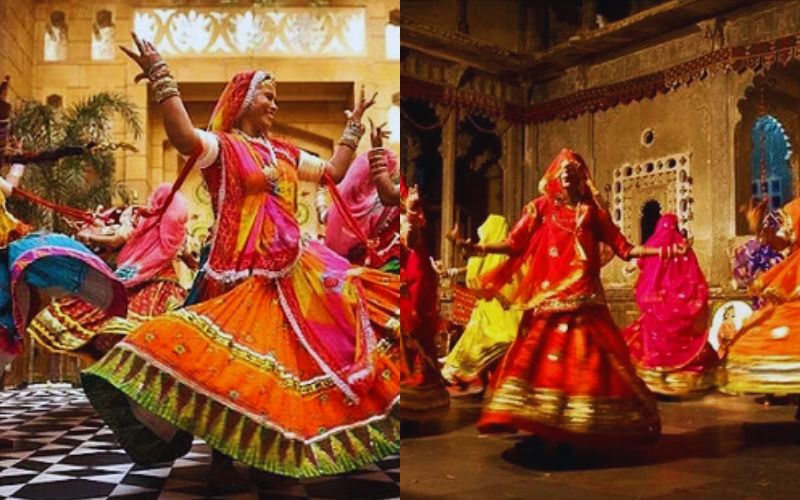
The Ghoomar dance is one of the most recognised folk dances of Rajasthan, and its captivating beauty stems from the graceful swirls of dancing skirts. The dance was traditionally performed by the Bhil tribe to worship Goddess Saraswati.
A social entertainment for women, this vibrant dance form is traditionally practised by the Bhil tribe in villages across Rajasthan. With women dressed in colourful ghaghra-cholis (long skirts with blouses) and adorned in intricate jewellery, this slow-paced dance is sure to take your breath away with its graceful moves.
2. Kalbelia Dance

Kalbelia is another entrancing folk dance form of Rajasthan that has been popularised around the world due to its sheer charm. This traditional gypsy dance is usually performed by the nomadic Kalbelia community and they often use props such as snake sticks, brass pots, and different kinds of handkerchiefs to add elements of drama.
The women sway gracefully as they perform this dance while wearing a traditional attire – a black skirt with silver embroidery. The performance is then accompanied by hypnotic singing and the melodious tunes of a Pungi (a traditional wind instrument). As they dance to the enchanting rhythm, it is sure to leave you mesmerised.
3. Bhavai Dance

Bhavai is one of the oldest folk dances in Rajasthan and has been performed for centuries. This folk art form from Marwar is a thrilling display of acrobatic stunts that require immense strength and skill to execute. It usually involves seven earthen pots placed on the heads of artistes as they dance around them.
The female dancers are dressed in traditional attire and perform this mesmerising dance while singing folklore songs. Bhavai is an entertaining spectacle for any audience, but it is also a celebration of the strength and agility that Rajasthan’s women possess.
4. Chari Dance
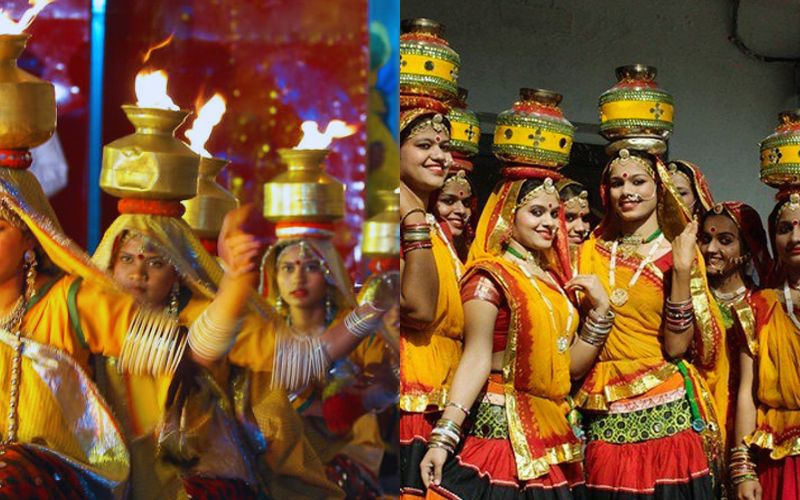
Chari is one of the most captivating forms of folk dance in Rajasthan. This upbeat and energetic dance form originated from the Khatik community living in the Shekhawati region of Rajasthan. It involves intricate footwork and sharp steps while dancers move around in a circle, balancing large brass pots filled with water on their heads.
The eye-catching costumes of the dancers, combined with their enthusiastic performance, make this dance a real treat for viewers. This traditional folk art is still alive and is celebrated in many parts of Rajasthan during the festive season.
5. Gair Dance
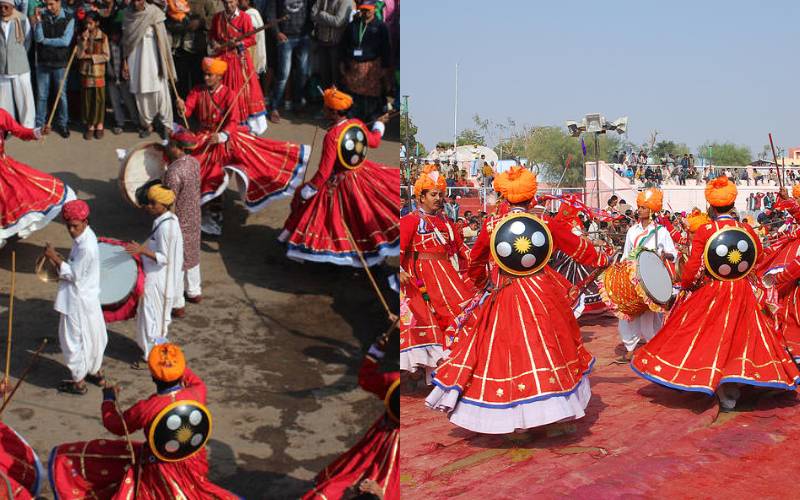
Gair is an invigorating dance form that originated from the Mewar region of Rajasthan. The word ‘Gair’ refers to the people who perform this vibrant dance form in their vibrant costumes with utmost grace and enthusiasm. This is a popular group dance usually performed during weddings and other festivities.
In this dance, the dancers challenge each other, performing various energetic steps and formations while the music’s rhythm keeps them moving together. It is amazing to watch these dancers perform as a team, perfectly in sync with each other. Gair is an entertaining dance performance that showcases the vibrancy and joy of Rajasthan’s culture.
6. Kachhi Ghodi Dance
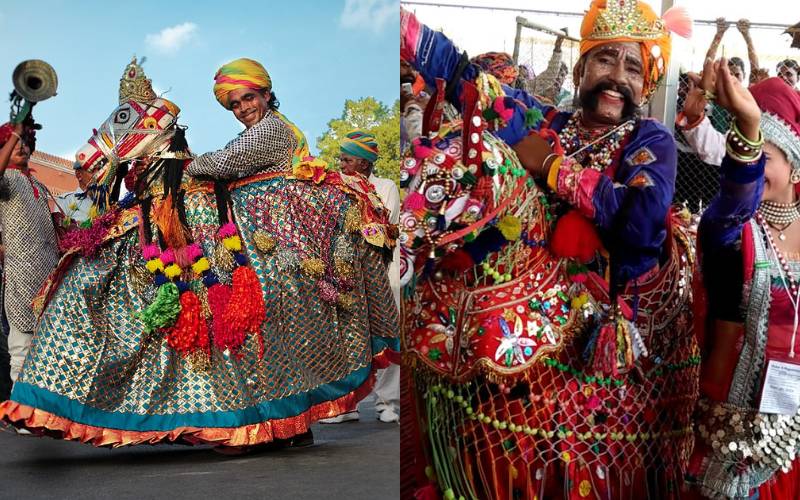
Kachhi Ghodi is an amazing and entertaining folk dance of the desert state, Rajasthan. This lively dance form is usually performed on occasions such as weddings and festivals. The name ‘Kachchhi Ghodi’ literally means wooden horse in Hindi as this performance involves a man dancing atop a decorated wooden horse.
As the dancer performs to the traditional Rajasthani music, he skillfully imitates the movements of a horse and its rider. The colorful costumes worn by the dancers along with their enthusiastic performance make this dance an exciting spectacle for viewers. Kachchhi Ghodi is one of the most popular folk dances of Rajasthan, and it is sure to leave viewers mesmerized.
7. Terah Taali Dance
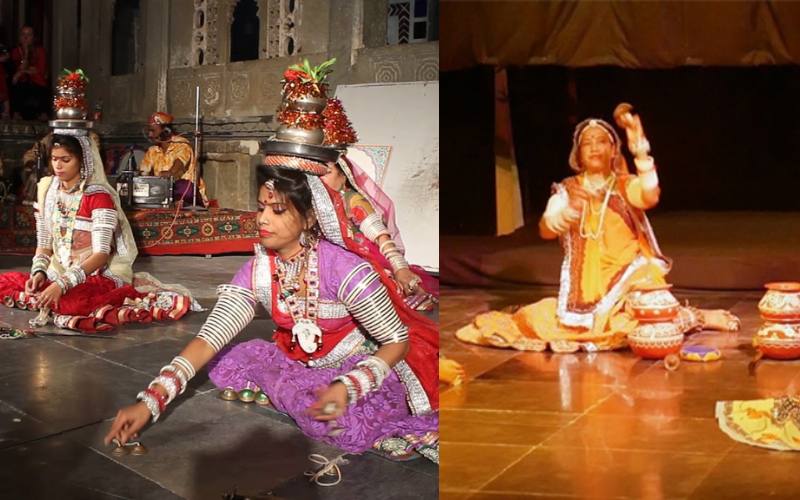
Terah Taali is an enthralling folk dance of Rajasthan that originated in the province of Marwar. This traditional dance form, also known as ‘Thirah Taal’, requires excellent coordination and agility from its performers. The dancers move their hands and feet rhythmically to the beat of drums as they create complex formations with their bodies.
Terah Taali is a unique art form that showcases the talent and skill of Rajasthan’s dancers. As the dance progresses, the tempo increases and performers challenge each other by forming intricate patterns with their bodies. This amazing performance is sure to leave viewers captivated with its lively energy and graceful movements.
8. Fire Dance
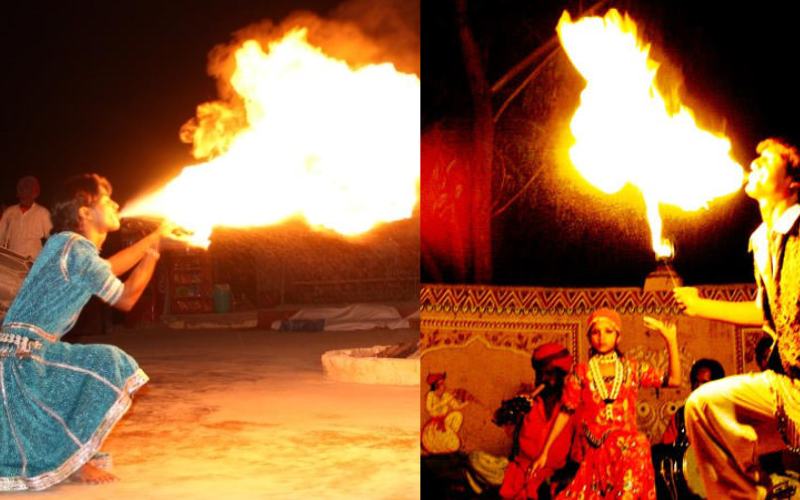
Fire Dance is an ancient and spectacular folk dance of Rajasthan. This mesmerizing performance involves a group of dancers balancing long poles on their head, hands and feet while the performers leap around flaming bonfires. Fire dancing has been popular in Rajasthan since the 15th century and is often performed at weddings and festivals.
The passionate movements of the performers combined with the sparks and heat of the bonfire create an unforgettable visual experience. Fire Dance is a thrilling dance form that showcases Rajasthan’s vibrant culture and heritage. It is sure to leave viewers spellbound with its fiery energy and captivating atmosphere.
9. Kathputli Dance

Kathputli or Puppet Dance is one of the most popular and oldest forms of folk dances in Rajasthan. It is a puppet show which is operated by a single string that passes it from the top of the puppet over the puppeteers. This form of art is known for its colourful outfits and vibrant music that add to the excitement of the performance.
The dance involves performing with puppet figures made from wood, cloth and leather. These puppets are creatively designed to depict various characters from popular stories or legends. Kathputli Dance is an enjoyable and unique art form that showcases the culture of Rajasthan. It is sure to captivate its audience with its lively music, thrilling movements and beautiful visuals.
10. Chang Dance

Chang Dance is a unique and exciting folk dance of Rajasthan. It is performed by pairs of men and women accompanied by vibrant music that propels the performers to spin around in circles. The Chang dance was traditionally performed at festivals like Teej, Gangaur and Gogaji and is still popular today for its amazing energy and cheerful atmosphere.
This highly energetic dance form is sure to leave its viewers mesmerized by its infectious spirit and captivating performances. It is truly a spectacle that reflects the culture and vibrancy of Rajasthan. So come experience the amazing Chang Dance at one of the many festivals in Rajasthan!
11. Dandi Gair Dance

Dandi Gair Dance is another traditional folk dance of Rajasthan. It involves performers wearing colourful and elaborate costumes, as they sing, dance and perform acrobatic moves to the accompaniment of vibrant festive music. This mesmerizing performance has been passed down through generations by the tribal people of Kishangarh region in Rajasthan.
Dandi Gair dance is sure to leave its viewers spellbound with its colorful and energetic movements. It is a true embodiment of the vibrant culture of Rajasthan and an absolute must-watch for anyone visiting this beautiful state! So don’t miss out on the chance to experience this unique dance form and soak in the spirit of Rajasthan!
12. Gindar Dance

Gindar Dance traditional folk dance form of Rajasthan that is performed by the Bhil tribe during the festival season. It involves male dancers donning colourful and ornate costumes as they perform vigorous and graceful movements to express their joy at the arrival of the new year.
The Gindar Dance uses various props including swords, sticks and shields while performers sing and dance in a circle. This captivating and unique performance is sure to leave its viewers mesmerized with its vibrant energy and colorful costumes.
13. Drum Dance

Drum Dance is a professional dance-form of the ‘Nayak’, ‘Bhil’ & ‘Dholi’ communities of Rajasthan. It involves dancers drumming on drums made from clay or metal, as they perform various steps and movements. This traditional dance form has been passed down through generations and it sure to leave its viewers mesmerized with its fast-paced rhythms and energetic movements.
Drum Dance is a great way to experience the vibrant culture of Rajasthan and an absolute must-watch for anyone visiting this amazing state! This unique dance form and submerge yourself in the spirit of Rajasthan!
14. Chakri Nritya
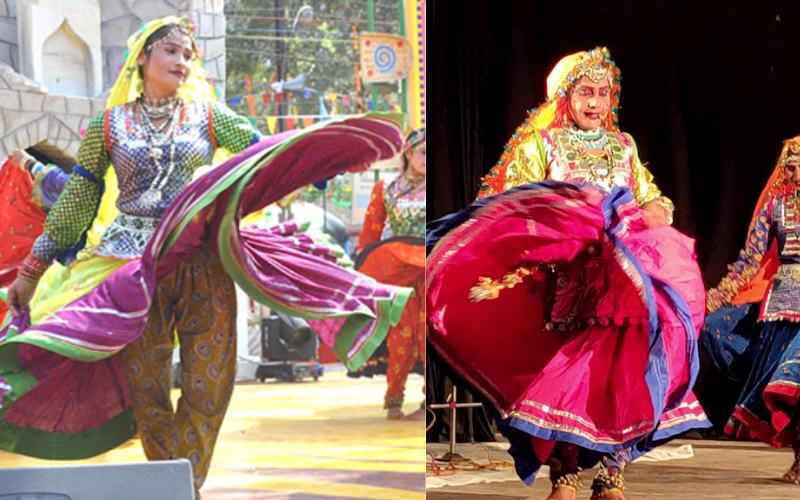
Chakri Nritya is a folk dance of men and women that has its origin in the Shekhawati region of Rajasthan. It involves dancers forming intricate patterns as they join hands while performing various steps related to martial arts.
This traditional dance form exhibits the strength and unity of the people of Rajasthan as it celebrates their unique culture and heritage. The dancers move swiftly in their colorful costumes, creating an unforgettable visual spectacle for their viewers. Chakri Nritya is an absolute must-watch for anyone visiting Rajasthan!
15. Jasnathi Nritya

Jasnathi Nritya is a folk dance unique to the Jasnathi community in the Churu district of Rajasthan. It involves dancers performing steps on hot coal embers during a fire ritual as part of their traditional practice. The daring and courageous performers adorn elaborate costumes and jewelry while they gracefully jump over burning embers.
This stunning display of strength and grace will surely leave its viewers mesmerized with its vibrant energy and colorful costumes. Jasnathi Nritya is a great way to experience the culture of Rajasthan, so don’t miss out on the opportunity to witness this traditional dance form!
Importance of Dance in Rajasthan
Dancing is an essential part of the culture in Rajasthan and its folk dances are a representation of this. Each dance form has a unique story and history behind it, which makes them even more special.
Dance: An Expressive Pillar of Rajasthani Culture
Do you know that dances can talk? Yes, they can! In Rajasthan, a place in India, dances tell stories. Rajasthan is famous not only for its impressive castles and forts but also for its lively and colorful dances.
Imagine you could speak without words. How would you do that? Well, in Rajasthan, they use dance to talk. They use the beat of their feet, the swing of their body, the spin of a dress, and the wave of their hands to share their feelings. Dance is like their secret language.
These dances are not just for fun. They are like a living storybook about Rajasthan’s brave kings, queens, exciting festivals, and everyday life. Take the Ghoomar dance, for example. Women perform this dance in bright, swirling dresses during celebrations. It’s like a big, happy party where the community shares their joy.
Role of Dance in Social and Cultural Events
Have you ever been to a party where everybody is dancing and having a great time? That’s what parties and festivals look like in Rajasthan, with dance being the heart of these events.
When there is a community get-together or a festival in Rajasthan, you’ll find people dancing with lots of energy and happiness. These dances are part of everything, whether it’s a happy wedding, a sacred ceremony, or a local fair.
Take the Kalbeliya dance, for instance. The Kalbeliya tribe performs this during Holi, the festival of colors. The dance is lovely, with movements like a snake. But it’s not just about the dance moves; it’s about the traditional black costumes, the live music, and the feeling of togetherness and fun.
Another exciting dance is the Bhavai dance. This dance is performed at social events and needs a lot of skill. Imagine dancing while balancing many earthen pots on your head or dancing on a sword or glass. It’s not just a dance; it’s an exciting show of balance and courage.
Summary: Embracing the Enchanting Diversity of Rajasthan’s Folk Dances
This article talks about 9 famous folk dances from Rajasthan. We look at the stories, art, and history behind each dance. These dances show the many traditions and colorful history of Rajasthan. I hope this story will make readers love these dances. Also, i hope it will help to keep these important parts of culture alive and known by more people. Thank you for reading this article.
FAQs
Q. How do Rajasthani folk dances reflect the region’s culture and history?
Rajasthani folk dances narrate stories of their history, symbolize cultural beliefs, and celebrate communal spirit, truly encapsulating the vibrant culture and rich history of the region.
Q. How have these dances evolved over time?
While the core essence of these dances has been preserved, they have adapted with time, embracing new music styles and fusion elements, to stay relevant and engaging for younger generations.
Q. How are Rajasthan folk dances different from classical dances?
Rajasthan folk dances are community-oriented and typically linked to local traditions and rituals. In contrast, classical dances are more structured, with defined rules and a focus on technique and perfection.
Q. Are there any specific costumes or attire for each dance form?
Yes, each Rajasthan folk dance has its distinctive costumes and attire. For example, Ghoomar dancers wear colorful, flared skirts called ghagras, while Kalbelia dancers adorn themselves with black swirling skirts and heavy silver jewelry.
Q. Can anyone learn and perform Rajasthan folk dances?
Yes, Rajasthan folk dances are open to anyone who wishes to learn and perform them. Many cultural academies and institutions offer training in these dance forms, allowing individuals to immerse themselves in the rich cultural heritage of Rajasthan.

